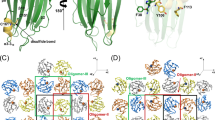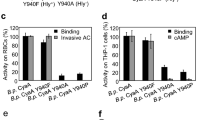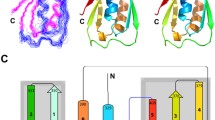Summary
The haemolysin protein (HlyA) of Escherichia coli contains 11 tandemly repeated sequences consisting of 9 amino acids each between amino acids 739 and 849 of HlyA. We removed, by oligonucleotide-directed mutagenesis, different single repeats and combinations of several repeats. The resulting mutant proteins were perfectly stable in E. coli and were secreted with the same efficiency as the wild-type HlyA. HlyA proteins which had lost a single repeat only were still haemolytically active (in the presence of HlyC) but required elevated levels of Ca2+ for activity, as compared to the wild-type haemolysin. Removal of three or more repeats led to the complete loss of the haemolytic activity even in the presence of high Ca2+ concentrations. The mutant haemolysins were unable to compete with the wild-type haemolysin for binding to erythrocytes at low Ca2+ concentrations but could still generate ion-permeable channels in artificial lipid bilayer membranes formed of plant asolectin, even in the complete absence of Ca2+. These data indicate that the repeat domain of haemolysin is responsible for Ca2+-dependent binding of haemolysin to the erythrocyte membrane. A model for the possible functional role of Ca2+ in haemolysis is presented.
Similar content being viewed by others
References
Benz R, Janko K, Boos W, Läuger P (1978) Formation of large, ion-permeable membrane channels by the matrix protein (porin) of Escherichia coli. Biochim Biophys Acta 511:305–319
Erb K, Vogel M, Wagner W, Goebel W (1987) Alkaline phosphatase which lacks its own signal sequence becomes enzymatically active when fused to N-terminal sequences of Escherichia coli haemolysin (HlyA). Mol Gen Genet 208:88–93
Felmlee T, Pellett S, Lee EY, Welch RA (1985a) Escherichia coli hemolysin is released extracellularly without cleavage of a signal peptide. J Bacteriol 163:88–93
Felmlee T, Pellett S, Welch RA (1985b) Nucleotide sequence of an Escherichia coli chromosomal hemolysin. J Bacteriol 163:94–105
Goebel W, Hedgpeth J (1982) Cloning and functional characterization of the plasmid-encoded hemolysin determinant of Escherichia coli. J Bacteriol 151:1290–1298
Härtlein M, Schießl S, Wagner W, Rdest U, Kreft J, Goebel W (1983) Transport of hemolysin by Escherichia coli. J Cell Biochem 22:87–97
Heijne Gv (1986) Mitochondrial targeting sequences may form amphiphilic helices. EMBO J 5:1335–1342
Hess J, Wels W, Vogel M, Goebel W (1986) Nucleotide sequence of a plasmid-encoded hemolysin determinant and its comparison with a corresponding chromosomal hemolysin sequence. FEMS Microbiol Lett 34:1–11
Kochan J, Perkins M, Ravetch JV (1986) A tandemly repeated sequence determines the binding domain for an erythrocyte receptor binding protein of P. falciparum. Cell 44:689–696
Koronakis V, Cross M, Senior B, Koronakis E, Hughes C (1987) The secreted hemolysins of Proteus mirabilis, Proteus vulgaris, and Morganella morganii are genetically related to each other and to the alpha-hemolysin of Escherichia coli. J Bacteriol 169:1509–1515
Kramer W, Drutsa V, Jansen HW, Kramer B, Pflugfelder M, Fritz HJ (1984) The gapped duplex DNA approach to oligonucleotide-directed mutation construction. Nucleic Acids Res 12:9441–9456
Ludwig A, Vogel M, Goebel W (1987) Mutations affecting activity and transport of haemolysin in Escherichia coli. Mol Gen Genet 206:238–245
Mackman N, Holland IB (1984) Functional characterization of a cloned haemolysin determinant form E. coli of human origin, encoding information for the secretion of a 107 K polypeptide. Mol Gen Genet 196:129–134
Mackman N, Nicaud JM, Gray L, Holland IB (1985) Identification of polypeptides required for the export of haemolysin 2001 from E. coli. Mol Gen Genet 201:529–536
Mackman N, Baker K, Gray L, Haigh R, Nicaud JM, Holland IB (1987) Release of a chimeric protein into the medium from Escherichia coli using the C-terminal secretion signal of haemolysin. EMBO J 6:2835–2841
Nicaud JM, Mackman N, Gray L, Holland IB (1985) Characterisation of HlyC and mechanism of activation and secretion of haemolysin from E. coli 2001. FEBS Lett 187:339–344
Sanger F, Nicklen S, Coulson AR (1977) DNA sequencing with chain-terminating inhibitors. Proc Natl Acad Sci USA 74:5463–5467
Springer W, Goebel W (1980) Synthesis and secretion of hemolysin by Escherichia coli. J Bacteriol 144:53–59
Strathdee CA, Lo RYC (1987) Extensive homology between the leukotoxin of Pasteurella haemolytica A1 and the alpha-hemolysin of Escherichia coli. Infect Immun 55:3233–3236
Vogel M, Hess J, Then I, Juarez A, Goebel W (1988) Characterization of a sequence (hlyR) which enhances synthesis and secretion of hemolysin in Escherichia coli. Mol Gen Genet 212:76–84
Vyas NK, Vyas MN, Quiocho FA (1987) A novel calcium binding site in the galactose-binding protein of bacterial transport and chemotaxis. Nature 327:635–638
Wagner W, Vogel M, Goebel W (1983) Transport of hemolysin across the outer membrane of Escherichia coli requires two functions. J Bacteriol 154:200–210
Wagner W, Kuhn M, Goebel W (1988) Active and inactive forms of hemolysin (HlyA) from Escherichia coli. Biol Chem Hoppe Seyler 369:39–46
Welch RA (1987) Identification of two different hemolysin determinants in uropathogenic Proteus isolates. Infect Immun 55:2183–2190
Author information
Authors and Affiliations
Additional information
Communicated by E.K.F. Bautz
Rights and permissions
About this article
Cite this article
Ludwig, A., Jarchau, T., Benz, R. et al. The repeat domain of Escherichia coli haemolysin (HlyA) is responsible for its Ca2+-dependent binding to erythrocytes. Mol Gen Genet 214, 553–561 (1988). https://doi.org/10.1007/BF00330494
Received:
Issue Date:
DOI: https://doi.org/10.1007/BF00330494




